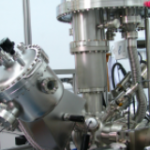Ultra High Vacuum System for XPS/UPS/AES (Specs)
FACILITIES / STIINTA-SUPRAFETEI

CHARACTERIZATION METHODS
X-ray Photoelectron Spectroscopy (XPS) – a spectroscopic technique based on photoelectric effect that measures the elemental composition, valence state and electronic state of the elements that exist within a material
Auger Electron Spectroscopy (AES) – an analytical technique based on Auger effect used for chemical characterization of surfaces and bulk materials
Scanning Tunneling Microscopy (STM) – a characterization technique based on quantum tunneling effect used for surface imaging at atomic resolution
EXPECTABLE OBTAINED DATA FROM XPS, AES and STM MEASUREMENTS
Elements and the quantity of those elements that are present within ~10 nm from the sample surface.
- Contamination from the surface or the bulk of the sample
- Empirical formula of materials
- Chemical state identification of elements (valence state, oxidation state)
- Binding energy (BE) of electronic states
- Thickness of thin layers (1–8 nm) of different materials on the surface
- Density of electronic states
- Depth compositional profile
- Surfaces morphology at the atomic level
PERFORMANCES
- Detects all chemical elements except hydrogen and helium
- Detection limits for most of the elements are in the parts per thousand range (1-3 ‰)
- High surface sensitivity since the electrons come from the first 10-20 layers of the surface
- High surface imaging resolution in STM technique: 0.2 Å
- Nondestructive analysis of materials: metals, alloys, ceramics and most glasses are not
- measurably degraded by X-rays. Polymers, catalysts, certain highly oxygenated
- compounds, various inorganic compounds and fine organics are low degraded by either
- monochromatic or non-monochromatic X-ray sources.
APPLICATIONS
- Materials and surfaces science
- Microelectronics
- Etching and corrosion processes (oxidation states of elements, chemical changes in surface
- composition, depth profiling)
- Heterogeneous catalysis (chemical species identification, chemical states of active species,
- chemical changes during reaction)
- Ascertainment of: the elemental composition, the chemical and electronic state of the
- elements existing on surface, the atomic composition on surface
- Control of the concentration of heavy metals or of the other pollutants in sediments and soil
Copyright © 2025 National Institute of Materials Physics. All Rights Reserved